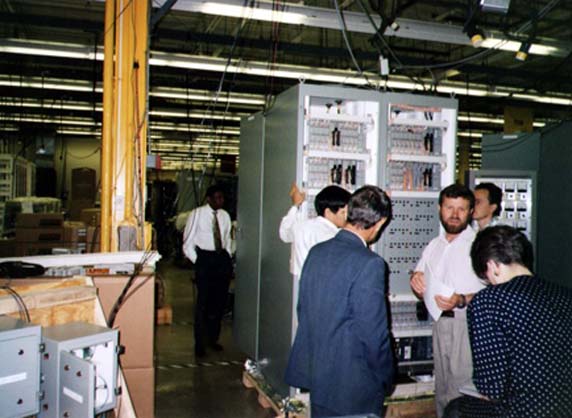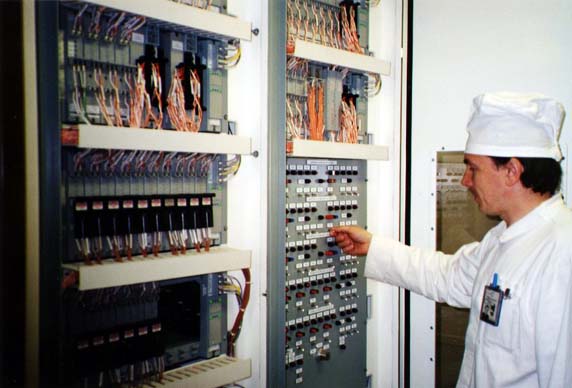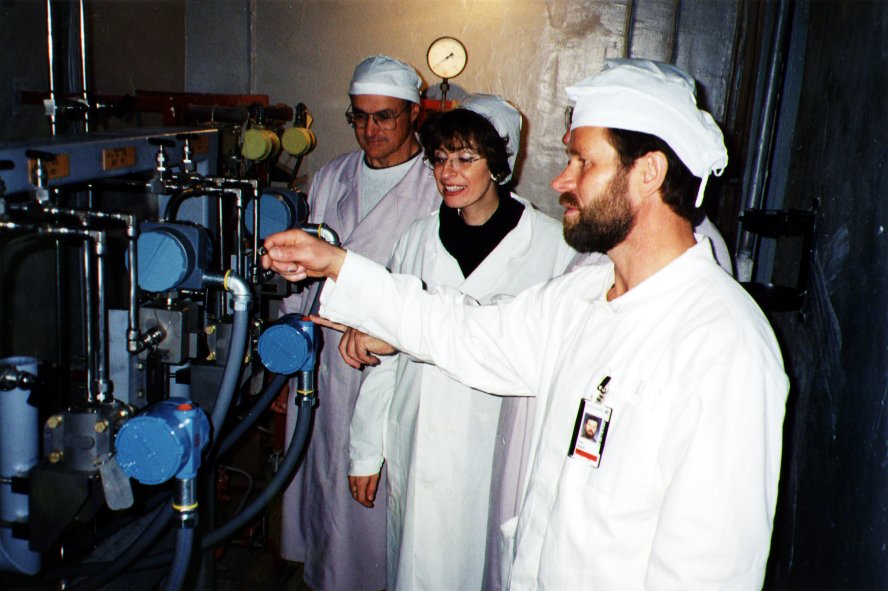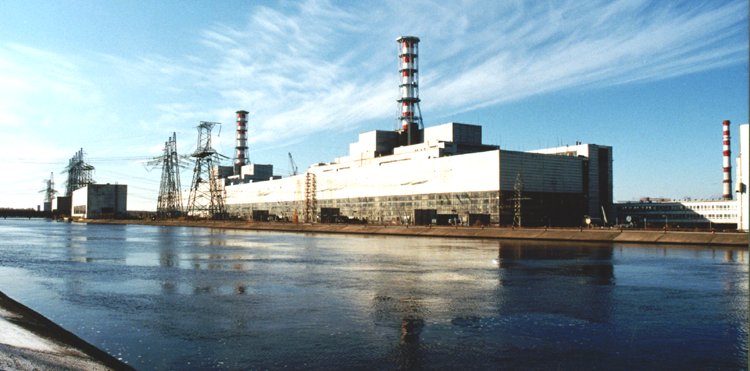
| October 1998 | - Armenia
- Bulgaria - Czech Republic - Hungary |
- Kazakhstan
- Lithuania - Russia - Slovakia |
- Ukraine
- United States - Cross-Cutting Activities - Planned Activities |
The October Activity Report documents safety improvements achieved in late September and October at Soviet-designed nuclear power plants through U.S. and host-country cooperation. To request a hard-copy version or to provide comments or suggestions, send an e-mail message to andrea.currie@pnl.gov.
Monthly Highlights
Reactor Protection System Installed on Time at Ignalina
One of the two largest nuclear power plants in the world faced a regulatory shutdown following this summer's planned outage unless its control-and-protection system was improved. Lithuania faced the loss of 41 percent of the country's electricity supply that the plant produces.
Instead, the 1,500-megawatt Ignalina nuclear power plant (NPP) Unit 1 reached full power in mid-October, thanks in part to a U.S. Department of Energy (DOE) project to create a redundant reactor protection system. The successful project was an intensive team effort funded by DOE and managed by DOE's Pacific Northwest National Laboratory (PNNL).
Additional team members included Parsons Power Group, Inc., which designed the new system to tough U.S. nuclear standards; Scientech, Inc., which conducted a mini safety analysis to prove the system would work; and the Foxboro Company, which designed and constructed the control cabinets. Lithuania's State Institute of Information Technology and the Lithuanian Energy Institute provided review and oversight.
 |
| Norman Fletcher, DOE program manager, Ron Wright, PNNL project manager (back to camera), and Victor Sidnev, Ignalina project manager, examine the control cabinets at the Foxboro Company factory. Quality assurance reviews and site acceptance tests were the responsibility of Ignalina NPP. |
During the installation, Ignalina plant staff became the critical players in an intense effort to finish the work in the large RBMK reactor on time.
The effort began more than a year ago when an international team reviewed the plant's safety analysis report and found significant deficiencies in the existing control-and-protection system. After the review, the Lithuanian Nuclear Power Safety Inspectorate ordered upgrades to the system.
The control-and-protection system is among the most critical safety equipment in a nuclear power plant. It is designed to rapidly shut down or "trip" the reactor under specified emergency conditions, such as decreased reactor coolant flow or significant pressure increases. The purpose is to prevent conditions that could lead to core damage and the release of radioactive materials to the atmosphere.
The project to build a new and redundant protection system began in earnest in September 1997. Some experts thought it impossible to put together an international project to build the system in nine months and install it in less than three. The DOE program manager committed to the project and fully supported PNNL in carrying it out.
Ignalina NPP took full responsibility for quality control and installation. U.S. experts helped train the Lithuanian staff in conducting quality reviews of the system components. Unit 1 staff participated in the factory acceptance test and conducted the site acceptance test. Equipment arrived at Ignalina NPP on July 3 without a single slowdown in shipping or customs clearance. U.S. nuclear standards, which were met by the project, required the wiring to be routed in conduit. The conduit arrived on July 10. Plant workers were unfamiliar with conduit, which had not been used during the original construction of the plant. All the same, they quickly mastered the process, installed the miles of required conduit, and color-coded each of the four channels of the system.
 |
| Vladimir Shailenkov checks the switch panel in the control cabinet for one channel of the four-channel control-and-protection system at Ignalina Unit 1. |
In a four-channel control-and-protection system, each channel gets a "vote" on whether to let the plant operate. If two of the four channels vote to trip the reactor, the reactor is automatically shut down at once. But if one channel is defective and indicates a plant trip, it cannot shut down the plant unnecessarily. Sensors that feed plant information into the system also have backups. For example, there are 32 flow transmitters--eight for each of the four channels of the system.
The new system is totally separate from the original control-and-protection system. Instead, it is a redundant system--one that meets the highest U.S. standards. It does not affect existing plant systems or the original design requirements.
 |
| Ron Wright, PNNL project manager (left), Zoya Voitenko, translator, and Victor Sidnev, Unit 1 project manager, inspect equipment for monitoring pressure in the new control-and-protection system at Ignalina NPP. |
Through effective teamwork on an international scale, what began as a "mission impossible" ended as a job well done. (Norman Fletcher, DOE, 301-903-3275; Ron Wright, PNNL, 509-372-4076)
Reactor Safety Systems OK in Year 2000
But Expect Unplanned Reactor Shutdowns
Year-2000 (Y2K) computer glitches may require reworking code and replacing systems on many facilities including nuclear power plants around the world. However, Y2K problems are not likely to impact critical safety systems at Soviet-designed NPPs. That was the bottom line of discussions at the first U.S./Russia Y2K Information Exchange Workshop held October 13 through 15 in Moscow.
During the exchange, staff of the DOE Office of International Nuclear Safety and Cooperation, supported by PNNL and selected technical experts, reviewed Y2K issues with representatives of the Ministry of Atomic Energy (Minatom), Rosenergoatom (Russian nuclear utility), Central Research and Science Institute (Atominform), Research and Development Institute of Power Engineering (RDIPE), All-Russian Science and Research Institute (VNIIAES), and Smolensk, Novovoronezh, Kalinin, and Balakovo NPPs.
Safety systems at Soviet-designed plants have analog rather than digital components. As a result, they are unaffected by the problems that can plague digital computers when two-digit representations of the year switch from 99 to 00, appearing to report the year as 1900 instead of 2000.
Nevertheless, problems with support computers could result in safe but unplanned reactor shutdowns. These problems could include faults in the plant process computer, the reactor physics calculations system, or the equipment diagnostic system. If these systems fail, plants must be shut down in 4 to 12 hours.
Computer-induced fluctuations of voltage and frequency in the electricity transmission and distribution grid also could cause unplanned reactor shutdowns. Although such shutdowns are not unsafe to the nuclear power plant, they could result in electricity shortages during an extremely cold time of year.
 |
| Year-2000 computer problems are not expected to impact critical reactor safety systems at Russia's nuclear power plants, according to information exchanged at an October workshop. |
Many of the anticipated shutdowns could be avoided with careful planning and specific Y2K procedures. As the Y2K-related problems are expected to occur on January 1, 2000, this date can be viewed as a predetermined event. With this in mind, having additional staff ready and trained to respond at the critical time would be an effective precaution.
One approach used in the United States--replacing outdated computer systems--is not an option for cash-starved Soviet-designed NPPs. On the other hand, because computer equipment is much less widespread, the Y2K problem is less extensive in Russia than in the United States.
In addition to the formal workshop, secondary meetings were held with the chairman of the Electric Power Council of the Commonwealth of Independent States Executive Committee and staff of the Central Distribution System of the Unified Energy System of Russia. U.S. team members met also with representatives of the U.S. Agency for International Development (U.S. AID) to coordinate U.S. AID activity in the Commonwealth of Independent States. A U.S. AID team was in Moscow performing a Y2K survey as part of a five-country tour.
In Russia, the State Communications Committee, Goskomsviaz, had issued a Y2K action directive, recognizing the need to address the Y2K problem. Minatom established a Y2K Coordinating Commission, which distributed an assessment survey to Minatom organizations. Rosenergoatom issued a letter to the nuclear power plants requesting they inventory and assess existing systems and components. The Russian regulator, Gosatomnadzor, has not issued any Y2K official guidance but has notified plants that Y2K inspections will be conducted.
Follow-on workshops to exchange information are planned for early in 1999. (Tanya Colgan, PNNL, 509-375-2054)
Novovoronezh Declares Analytical Simulator Ready for Training. On September 22, representatives of Novovoronezh NPP officially accepted an analytical simulator provided to the plant by the U.S. team in July 1998. Since July, the simulator has undergone extensive testing. After successful test completion, the simulator was declared ready for training by Novovoronezh officials. Witnessing the acceptance and readiness declaration were representatives of LAKROM (the Russian simulator vendor) and Rosenergoatom along with U.S. specialists from DOE's Brookhaven and Pacific Northwest national laboratories. The simulator will train operators for the Novovoronezh Unit 3 control room. (Peter Kohut, BNL, 516-344-4982)
First of Two Safety Parameter Display Systems Installed at Novovoronezh. During the first week of October, all installation work was completed for the Novovoronezh Unit 3 safety parameter display system (SPDS). Most of the actual work was done during the plant's fall outage, which began August 21. The system began site acceptance testing on October 21.
At the conclusion of the testing on October 23, the Site Acceptance Testing Witness Committee accepted the system for operation. Committee members include key officials from Rosenergoatom, Gosatomnadzor, VNIIAES, CONSYST, and Novovoronezh NPP. On October 27, U.S. and Russian representatives signed the system turnover protocol.
The Novovoronezh Unit 3 system is the first of two SPDSs to be installed in a Russian plant with a VVER-440 reactor. Science Applications International Corporation, under the direction of Burns & Roe Enterprises, Inc., was the main contractor for the successful installation. (Norman Fletcher, DOE, 301-903-3275; Frank Panisko, PNNL, 509-372-4472)
Control Room Simulator Projects Reviewed. Simulator projects under way for Ukrainian NPPs were reviewed during a late-September meeting held in Kyiv. Reviewers included representatives of Rivne, South Ukraine, and Zaporizhzhya NPPs; Energoatom; Ukraine's Engineering and Technical Center for the Training of Nuclear Personnel; GSE Power Systems, Inc.; and DOE's Brookhaven and Pacific Northwest national laboratories.
Kickoff deliberations were held for the Rivne Unit 3 and South Ukraine Unit 1 simulator projects. Items discussed included the appropriate site for simulator software staging, long-term lodging at the NPP sites for the development team, simulator documentation, and status of construction of buildings to house the simulators. Agreements were reached on the resolution of many of these items.
The status of the Zaporizhzhya Unit 5 full-scope simulator upgrade project also was reviewed. The completed tasks and the schedule for the remaining tasks were discussed and agreements reached. In addition, preliminary discussions on the planned full-scope simulator for Zaporizhzhya Unit 1 also were held. (Peter Kohut, BNL, 516-344-4982)
Ukrainian Specialists to Draft National Standard for NPP Worker Training and Qualification. In early October, U.S. training specialists from DOE; Sonalysts, Inc.; PATH Training; and Susquehanna NPP conducted a week-long seminar in Kyiv for participants from the Engineering and Technical Center and Ukraine's five NPPs. The workshop was held to assist the Ukrainian specialists who will draft criteria for use in a national standard for the training and qualification of NPP personnel. U.S. training experts will review the draft criteria and provide comments for use in developing the final criteria. (Peter Kohut, BNL, 516-344-4982)
Training Technology Being Transferred to Ukrainian NPPs. The first working visit in support of the second phase of the training technology transfer project began October 19 in Kyiv. The two-week working visit was focused on task analysis and design of a course for the shift supervisor position. Training experts from Sonalysts, Inc., and Khmelnytskyy NPP are providing technical assistance as well as collaborating on course development. Training specialists from South Ukraine, Rivne, and Zaporizhzhya NPPs and the Engineering and Technical Center also are supporting the effort. (Peter Kohut, BNL, 516-344-4982)
Groundwork Laid for Quality Assurance Improvements. On October 6 and 7, U.S. specialists from Scientech, Inc., and PNNL held discussions in Kyiv with representatives of Energoatom, the Nuclear Power Plant Operational Support Institute (NPP OSI), and British Energy on cooperative efforts to improve quality assurance within Ukraine. A memorandum of understanding was signed to acknowledge the joint efforts and intent to avoid project overlap. This coordination with British Energy will serve to better address needs at Energoatom while continuing U.S. activities to improve procedures at Ukraine's NPPs. (Lief Erickson, PNNL, 509-372-4097)
Ukraine Working Group Submits Draft Manual to Ukraine Regulatory Body. The Ukraine Quality Assurance Working Group met in Kyiv on October 19 through 22. Representatives of British Energy and Scientech, Inc., participated in the meetings. Participants from Ukraine included representatives from Energoatom, the NPP OSI and its subcontractors, and all five of Ukraine's NPPs. The group completed the initial draft of the General Quality Assurance Manual, which was submitted to the Nuclear Regulatory Administration (NRA) for review.
Ukraine Operational Safety Infrastructure Effort Reviewed. On October 7, a PNNL specialist met in Kyiv with NPP OSI representatives to discuss progress on the Infrastructure Strategic Plan and plans for 1999. The draft plan completed in September will be finalized during the next several months. The NPP OSI has received some comments on the draft plan from Energoatom but is expecting further direction prior to finalizing the plan. The NPP OSI soon will identify the type of support it will request for 1999, which will be part of that plan. Completion of the strategic plan and support of the NPP OSI will provide for development of resources to improve the safety and efficiency of NPPs in Ukraine. (Lief Erickson, PNNL, 509-372-4097)
Computer Equipment Delivered for Reliability Database. Computer equipment for the reliability database was delivered to Energoatom during October. The equipment will be provided to three Ukrainian NPPs--Rivne, South Ukraine, and Khmelnytskyy--the pilot plant sites for the Ukraine reliability database project. The equipment, delivered by Kalyna Computers in Kyiv, will support the database project at the pilot plant sites. (Grigory Trosman, DOE, 301-903-3581; Tom Vehec, PNNL, 509-372-4072)
Classes in Technical English To Be Held in Ukraine. To implement technology transfer activities, the U.S. team is providing technical English classes in support of the Khmelnytskyy NPP in-depth safety assessment. Task orders signed during October will support the classes for personnel from Khmelnytskyy NPP and its contractor, Kyiv Energoprojekt. (Charles Dickerman, ANL, 630-252-4622)
Agreement Reached on Details of Khmelnytskyy Safety Assessment. Representatives of Khmelnytskyy NPP and its subcontractor Kyiv Energoprojekt met with U.S. team representatives during the week of October 11. Agreement was reached on final details of the drafts for the Phase I work plan and the Phase I project management task. Final details of the project guidelines task also were agreed upon. (Charles Dickerman, ANL, 630-252-4622)
Plans Made for Future Rivne Safety Assessment Work. Representatives of Rivne NPP and its Ukrainian subcontractor Energorisk met with U.S. specialists at Rivne NPP during the week of October 18. After reviewing progress on three ongoing in-depth safety assessment tasks, they agreed on additional technical transfer activities and on the basic approach for integrating analyses of emergency operating instructions with calculations from the Level 1 probabilistic risk assessment. This integration process is planned to conserve resources, expedite schedules, and ensure consistency and quality. Work is on schedule to meet the March 1999 delivery date for the base RELAP5 input data deck that will support both analyses. (Charles Dickerman, ANL, 630-252-4622)
Nuclear Service Water Pumps Shipped to Armenia; System Construction Nearing Completion. Six pumps to provide water for a spray pond cooling system at Armenia NPP were delivered to the plant site on October 12. The pumps, manufactured and tested at the Intersigma facility in the Czech Republic, are ready for installation into the pump stations. By the end of October, structural work on the two pump stations was completed. Work on the related electrical, heating, ventilating, and air-conditioning systems is nearing completion. The last layer of reinforced concrete is being applied to the three spray ponds. Some delay is being experienced in the receipt of equipment (the remaining 30 percent of the electrical cable, the control system, and the polymer coating for the spray ponds) being provided by Russia using Russian credits. The electrical tunnels are complete, but spreading of cable cannot occur until the remaining cable is received from Russia. Although the system is expected to be completed and the components tested by the end of December, system tie-in to the plant, testing, and commissioning will be scheduled for the first outage in 1999. (Rich Denning, PNNL, 614-424-7412)
Workshop Highlights Progress Toward Final Kozloduy Emergency Operating Instructions. Organizations working with Kozloduy NPP specialists to develop and implement symptom-based emergency operating instructions (EOIs) were hosted by Energoproekt at a workshop during the week of October 5 in Sofia. Participants reviewed progress toward finishing the thermal-hydraulic analysis needed to complete the technical basis documents that will validate operator actions spelled out in the draft EOIs. Kozloduy is the first NPP site with VVER reactors to begin EOI analysis and development of the final technical basis documents.
Workshop participants included representatives of Kozloduy NPP, the Bulgarian Academy of Sciences Institute of Nuclear Research and Nuclear Energy (INRNE), and the Committee on the Use of Atomic Energy for Peaceful Purposes (CUAEPP, Bulgaria's nuclear regulatory agency). U.S. team members from Science Applications International Corporation and DOE's Argonne and Pacific Northwest national laboratories also participated.
Substantial progress was noted in several areas as the participants exchanged information:
All participants signed a memorandum of understanding, detailing the expectations for developing safety analysis capabilities and completing the EOI thermal-hydraulic analysis in Bulgaria. (Kent Faris, PNNL, 509-372-4068)





 "*" indicates the event is a new item or has been changed from the last report.
"*" indicates the event is a new item or has been changed from the last report.